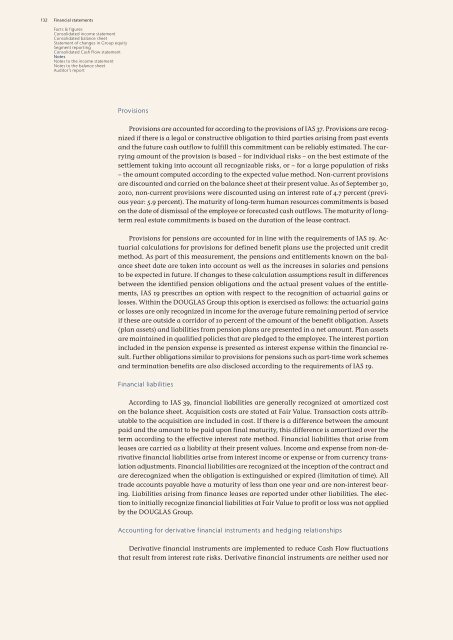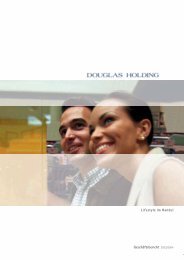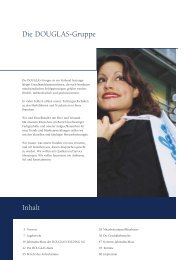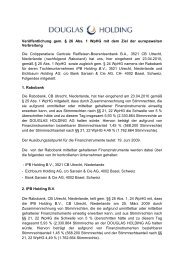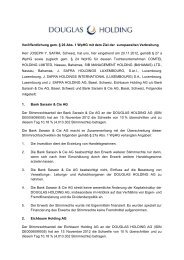Annual Report 2009/10 Excellence in Retailing - Douglas Holding
Annual Report 2009/10 Excellence in Retailing - Douglas Holding
Annual Report 2009/10 Excellence in Retailing - Douglas Holding
Create successful ePaper yourself
Turn your PDF publications into a flip-book with our unique Google optimized e-Paper software.
132 F<strong>in</strong>ancial statements<br />
Facts & figures<br />
Consolidated <strong>in</strong>come statement<br />
Consolidated balance sheet<br />
Statement of changes <strong>in</strong> Group equity<br />
Segment report<strong>in</strong>g<br />
Consolidated Cash Flow statement<br />
Notes<br />
Notes to the <strong>in</strong>come statement<br />
Notes to the balance sheet<br />
Auditor’s report<br />
Provisions<br />
Provisions are accounted for accord<strong>in</strong>g to the provisions of IAS 37. Provisions are recognized<br />
if there is a legal or constructive obligation to third parties aris<strong>in</strong>g from past events<br />
and the future cash outflow to fulfill this commitment can be reliably estimated. The carry<strong>in</strong>g<br />
amount of the provision is based – for <strong>in</strong>dividual risks – on the best estimate of the<br />
settlement tak<strong>in</strong>g <strong>in</strong>to account all recognizable risks, or – for a large population of risks<br />
– the amount computed accord<strong>in</strong>g to the expected value method. Non-current provisions<br />
are discounted and carried on the balance sheet at their present value. As of September 30,<br />
20<strong>10</strong>, non-current provisions were discounted us<strong>in</strong>g an <strong>in</strong>terest rate of 4.7 percent (previous<br />
year: 5.9 percent). The maturity of long-term human resources commitments is based<br />
on the date of dismissal of the employee or forecasted cash outflows. The maturity of longterm<br />
real estate commitments is based on the duration of the lease contract.<br />
Provisions for pensions are accounted for <strong>in</strong> l<strong>in</strong>e with the requirements of IAS 19. Actuarial<br />
calculations for provisions for def<strong>in</strong>ed benefit plans use the projected unit credit<br />
method. As part of this measurement, the pensions and entitlements known on the balance<br />
sheet date are taken <strong>in</strong>to account as well as the <strong>in</strong>creases <strong>in</strong> salaries and pensions<br />
to be expected <strong>in</strong> future. If changes to these calculation assumptions result <strong>in</strong> differences<br />
between the identified pension obligations and the actual present values of the entitlements,<br />
IAS 19 prescribes an option with respect to the recognition of actuarial ga<strong>in</strong>s or<br />
losses. With<strong>in</strong> the DOUGLAS Group this option is exercised as follows: the actuarial ga<strong>in</strong>s<br />
or losses are only recognized <strong>in</strong> <strong>in</strong>come for the average future rema<strong>in</strong><strong>in</strong>g period of service<br />
if these are outside a corridor of <strong>10</strong> percent of the amount of the benefit obligation. Assets<br />
(plan assets) and liabilities from pension plans are presented <strong>in</strong> a net amount. Plan assets<br />
are ma<strong>in</strong>ta<strong>in</strong>ed <strong>in</strong> qualified policies that are pledged to the employee. The <strong>in</strong>terest portion<br />
<strong>in</strong>cluded <strong>in</strong> the pension expense is presented as <strong>in</strong>terest expense with<strong>in</strong> the f<strong>in</strong>ancial result.<br />
Further obligations similar to provisions for pensions such as part-time work schemes<br />
and term<strong>in</strong>ation benefits are also disclosed accord<strong>in</strong>g to the requirements of IAS 19.<br />
F<strong>in</strong>ancial liabilities<br />
Accord<strong>in</strong>g to IAS 39, f<strong>in</strong>ancial liabilities are generally recognized at amortized cost<br />
on the balance sheet. Acquisition costs are stated at Fair Value. Transaction costs attributable<br />
to the acquisition are <strong>in</strong>cluded <strong>in</strong> cost. If there is a difference between the amount<br />
paid and the amount to be paid upon f<strong>in</strong>al maturity, this difference is amortized over the<br />
term accord<strong>in</strong>g to the effective <strong>in</strong>terest rate method. F<strong>in</strong>ancial liabilities that arise from<br />
leases are carried as a liability at their present values. Income and expense from non-derivative<br />
f<strong>in</strong>ancial liabilities arise from <strong>in</strong>terest <strong>in</strong>come or expense or from currency translation<br />
adjustments. F<strong>in</strong>ancial liabilities are recognized at the <strong>in</strong>ception of the contract and<br />
are derecognized when the obligation is ext<strong>in</strong>guished or expired (limitation of time). All<br />
trade accounts payable have a maturity of less than one year and are non-<strong>in</strong>terest bear<strong>in</strong>g.<br />
Liabilities aris<strong>in</strong>g from f<strong>in</strong>ance leases are reported under other liabilities. The election<br />
to <strong>in</strong>itially recognize f<strong>in</strong>ancial liabilities at Fair Value to profit or loss was not applied<br />
by the DOUGLAS Group.<br />
Account<strong>in</strong>g for derivative f<strong>in</strong>ancial <strong>in</strong>struments and hedg<strong>in</strong>g relationships<br />
Derivative f<strong>in</strong>ancial <strong>in</strong>struments are implemented to reduce Cash Flow fluctuations<br />
that result from <strong>in</strong>terest rate risks. Derivative f<strong>in</strong>ancial <strong>in</strong>struments are neither used nor


